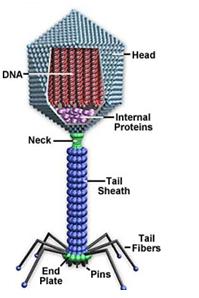Originally, the term “Virus” comes from a Latin word that refers to poison and other noxious substances. According to Wikipedia, the Free Encyclopedia, a virus is a “small infectious agent that can replicate only inside the living cells of organisms”. Viruses are of various different types, but they all infect all kinds of organisms and they all have exactly the same anatomical structure.
Although viruses attack living organisms, there is a great controversy about whether to regard them as living organisms or not. Viruses have been described as “organisms at the edge of life” due to the fact that they possess genes but not a cellular structure as any other living organism. Surprisingly, viruses evolve by natural selection and have the ability to reproduce by creating multiple copies of themselves in no time. This reproducing feature is what makes viruses invincible.
As shown in the Figure, which is a graphic mimic of how a typical virus looks like under a microscope; the virus consists of nucleic acid, either DNA or RNA, and a protein coat that envelops that nucleic acid. Since a virus does not constitute naturally of a cell, it does not have its own metabolism. Thus, it needs another host cell so that it can reproduce and perform its functions. Viruses also cannot synthesize proteins as they lack ribosomes, which are vital for transforming RNA that exists in any virus to proteins that are vital for the reproducing process. Moreover, viruses can neither generate nor store energy, so they have to derive their energy along with other metabolic functions from the host cell.

Viruses differ in types, but they also differ in their composition. Nevertheless, they all pass through the same phases when attacking a cell, or when looking for a host to reproduce. There are six main stages in a virus’s lifecycle:
- Attachment: This first stage, in a virus’s lifecycle, is when a virus attaches itself to a receptor living cell. For a virus to infect a host cell, that cell must have receptors for the virus on its surface and also be capable of supporting viral replication. These host cell receptors are normal surface molecules involved in routine cellular function, but since a portion of a molecule on the viral surface resembles the chemical shape of the body's molecule that would normally bind to the receptor, the virus is able to attach to the host cell's surface.
- Penetration: During this phase, the Virion, which, according to theFreeDictionary.com, is “a complete viral particle, consisting of RNA or DNA surrounded by a protein shell and constituting the infective form of a virus”, enters the host cell either through endocytosis(1) or membrane fusion.
- Un-coating: During this phase, the whole viral capsid is removed. This phase leads to the release of the viral genomic nucleic acid from the protein coat.
- Replication: This phase involves the multiplication of the genome and the synthesis of the viral messenger RNA (mRNA). The viral genome directs the host cell's metabolic machinery (ribosomes, tRNA, nutrients, energy, enzymes) to synthesize viral enzymes and viral parts. The viral genome has to both replicate itself and become transcribed into viral mRNA molecules. The viral mRNA can then be translated by the host cell's ribosomes into viral structural components and enzymes need for replication and assembly of the virus.
- Self-Assembly: This is all about the self-assembly of the virus particles. Usually, some modifications in the protein created take place. Amidst that stage, the viruses mature.
- Lyses: This can be regarded as the most devastating and horrific stage for the host cell. This is because during that phase, the virus is released from the host cell by bursting the cell membrane and cell wall leading to the destruction of the host cell.
Glossary
Endocytosis: is a process whereby cells absorb material (molecules such as proteins) from the outside by engulfing it with their cell membrane.
References
www.encyclo.co.uk
www.thefreedictionary.com
www.healthfreefaq.com
www.news-medical.net
student.ccbcmd.edu
discovermagazine.com
portal.acs.org
kidshealth.org
ChemistryDaily.com
The original article was published in the PSC Newsletter, Summer 2011 issue.